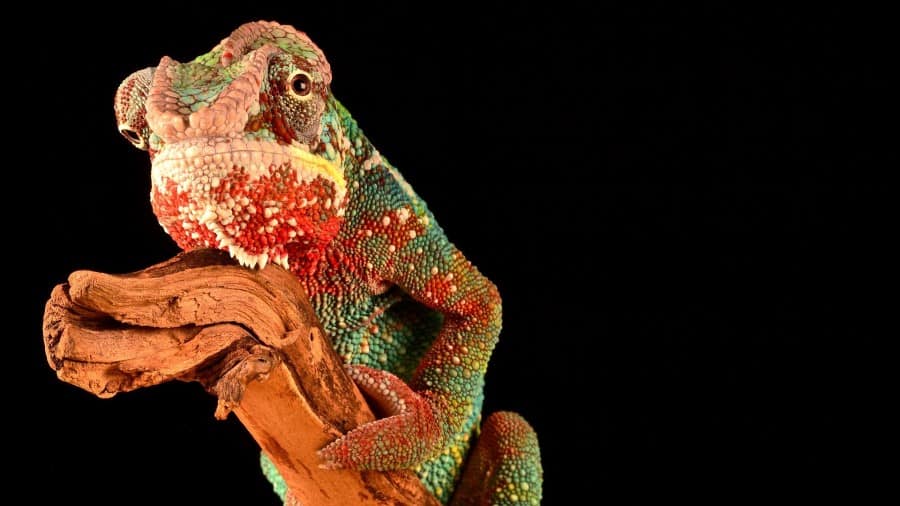
Chameleons have always been associated with their ability to change into different colors. Makes you wonder if this is a natural reflex or an active ability that they have. Do they even know what colors they change into and when it happens?
Chameleons know when they change color because they need to tell their bodies to change into a specific color. Contrary to the belief, chameleons don’t change color as a way to camouflage. Instead, they convey their emotions through color.
Unlike some phenomenal things that animals can do that are simply reflexes, chameleons need to consciously tell their bodies to change into specific colors. It might seem weird to hear that an animal can will a color into existence. How do they change colors in the first place?
How Do Chameleons Change Color?
It seems like color changing is a type of superpower. It has even been depicted in many comics nowadays as a camouflage technique.
With all that said, there is a scientific explanation as to how a chameleon can change color. Do you know the skin that chameleons shed every month or so?
That skin is only the most outer layer of a chameleon’s many skin layers. This layer is transparent to show off their abilities because all the magic happens underneath it.
Underneath the transparent skin, chameleons have multiple layers of skin containing chromatophores, which are specialized cells. These cells have multiple pigments stored in them with each different layer.
For simplicity’s sake, I will refer to these cells by their colors instead of the name. The deepest of these layers contain a brown pigment that can be found in most humans as it’s the same pigment that gives us our shade of color.
On top of that, there are blue pigments that reflect blueish to white light. After that, there will be pigments of red and yellow respectively.
Under normal circumstances, these pigments are stored deep inside the tiny sacs found within their respective cells. This allows the natural colors of the chameleon to show. When a chameleon goes through a mood or temperature change, these cells activate.
Their nervous system signals specific cells to open and close. Then, their brain will send out hormones into the body to tell it what color to change to.
Multiple combinations will then work together to create the desired color. With so many combinations possible, chameleons can create any color and any pattern they want to.
There is a misconception that chameleons change color to blend into the background. They actually do it for other reasons…
Why Do Chameleons Change Color?
Many people associate the stealth powers of invisibility with the color-changing chameleon. This can’t be any further from the truth.
Chameleons change colors due to many other reasons instead. Here are some of the reasons why a chameleon changes color.
Mood
Chameleons change color in correspondence to their current mood. This their way of communicating how they feel to other animals.
This isn’t random though, as specific colors are used to show specific moods. Bright colors like red and pink are used when a chameleon feels excited or angry, which shows extreme emotions.
Calmer chameleons tend to keep their shades of green with different shades varying with their level of comfort. When a chameleon starts to get stressed out, it will show darker colors of grey or even black.
Black is the worst color to show on a chameleon as it tends to mean that they are starting to shut themselves down as well. But emotions aren’t the only thing chameleons show with colors though…
Communication
Like how we use language as a means to communicate, chameleons use color instead. Their wide array of colors is used to convey certain messages other than stress.
Other species of animals can’t tell exactly what it is but certain colors have a general meaning to them anyway. When a chameleon is ready to mate or is trying to woo a mate, it will show multiple colors in a variety of patterns as a way to impress the other sex.
However, when confronting a threat or chameleons of the same sex, they will show off their brightest colors to assert their dominance. Their bark is worse than their bite though as a chameleon rarely engages in any physical confrontation anyway.
You can see how a chameleon uses these bold colors to get its message across clearly instead of camouflage. There is one last thing that chameleons change color for that is quite practical…
Temperatures
If you’ve paid attention during science class, you would know that certain colors absorb or repel more heat than others. Lighter colors tend to be cooler while darker colors are more heat absorbent.
Chameleons may not be smart, but they are smart enough to know this. This is why when a chameleon feels hot, it tends to show a lighter shade color in an attempt to cool off.
When a chameleon starts to get darker, you might want to look into their enclosure’s temperature to ensure that they are warm enough. Chameleons are cold-blooded animals that can’t regulate their temperature biologically, so they need to use the environment to regulate it.
This is also one of the reasons why their color-changing abilities are so important to them. With so many factors in mind, it isn’t exactly easy to know what a chameleon is feeling or trying to convey, but it gives off a general message.
How Do Chameleons Know What Color to Change to?
As mentioned, chameleons aren’t very smart animals, but it’s amazing how they know what color to change to for specific reasons. This isn’t because they are well versed in communication or the language of science though.
These creatures have been roaming around the earth for millions of years, going through generations of evolution. With each evolution, they learn a little more from their predecessors.
You can see how the accumulation of knowledge shaped them into what they are today. With each trial and error, chameleons will know what colors to change to for a specific effect.
It’s not perfect, but it works most of the time. The animal kingdom may not have a language like we do, but for many years, specific colors have meant specific things for them.
Brighter colors like red signify ferocity and dominance, while darker shades tend to show a more harmless or relaxed demeanor. This is how a chameleon knows what color to change to when a situation arises.
As we’ve previously mentioned, they use color as a way of communication within themselves as well. So when a chameleon turns into a specific color, the other chameleon will get the message because it is the same thing they would do if presented the same situation as well.
With temperature, it’s simply just using their feelings. They can’t regulate their body temperatures biologically, so they are more sensitive to warmth since they need it for survival. They will be able to tell if a specific color makes them cooler or hotter.
Conclusion
Chameleons are aware when they change colors because their brains have to send signals to the body to tell it what to change to. It isn’t just a natural reaction or their bodies working on their own as most people would assume.
Chameleons change colors to convey a mood, message, or even to regulate their temperatures. It’s interesting how a simple color change can be used in so many ways.
What’s more interesting is how a chameleon knows what to change to for certain situations. They have been alive for so long, they just keep passing down information for the survival of the next generation.
Their vivid colors may not help them to blend into the background better, but it sure does show a certain message clearly.


